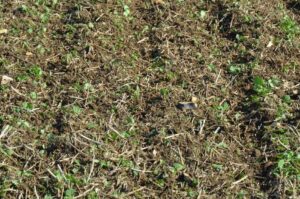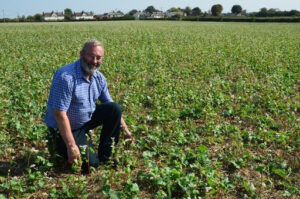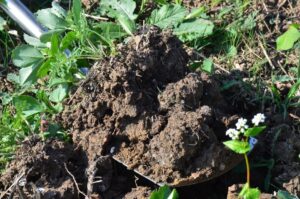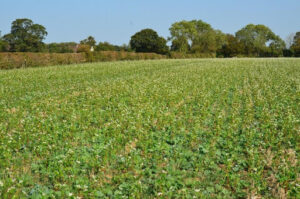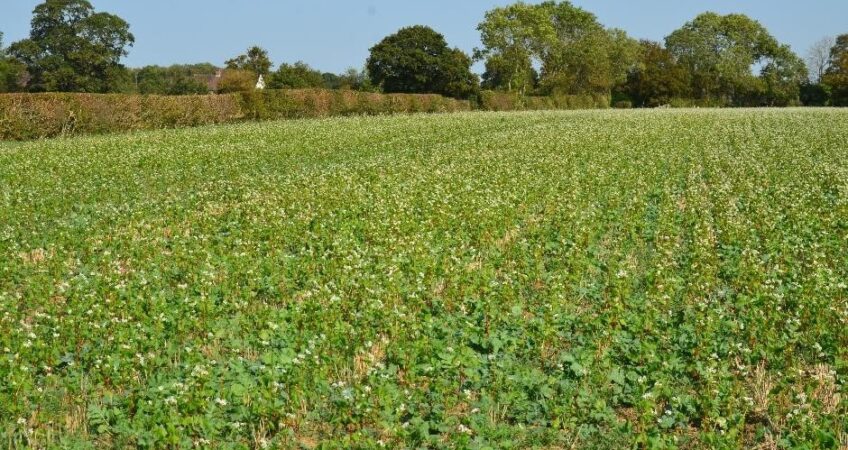
We have been trialling cover crops on our farm with agronomy company Hutchinsons to assess the interaction between different stubble management techniques, establishment methods and cover crop mixes. Cover crops are relatively inexpensive and easy to establish and can deliver significant agronomic, economic and environmental benefits. They can increase soil biota levels and biodiversity, improve soil structure and build organic matter content. Cover crops help to reduce erosion, harness nutrients and suppress weeds.
CHOOSING THE RIGHT MIX
Hutchinsons offer three over-winter cover crop mixes and we are trialling MaxiCover. This is a general-purpose mix which is drilled at 12.5kg/ha and suits a wide variety of situations and soil types. MaxiCover should be drilled as soon as possible in the summer after the previous crop has been harvested, and certainly no later than mid-September.
MaxiCover contains linseed (28.5%), buckwheat (8%), phacelia (11%), daikon radish (2.5%), fodder radish (5.5%), brown mustard (13%), hairy vetch (7%) and crimson clover (24.5%). It offers a wide diversity in terms of plants and rooting structures, which penetrate both vertically and horizontally, and help to structure the soil and create drainage channels.
Dick Neale from Hutchinsons explains about the mix: “Having various plant canopy profiles provides good soil armour and weather protection which has a positive effect in terms of controlling grassweeds, as well as further improving soil condition. The mix also contains legumes, forbs (any herb that is not a grass or grass like) and brassicas which provides a varied food source for soil microbes, while its diversity and the low inclusion rate of each plant type reduces the risk of exacerbating rotational pest or disease issues.
“The buckwheat in MaxiCover is extremely reliable and will grow almost anywhere, but very susceptible to frost. The heavy calcareous clay soil on the Claydon farm has a high calcium base and this attracts phosphate and locks it up, so plant roots can have difficulty in accessing this vital nutrient. Buckwheat produces acids which help to release phosphate and therefore plays a valuable role in achieving a correct nutrient balance in the soil.
“Fodder radish aids weed suppression, while its large taproot helps to improve soil structure by breaking up compaction and scavenging nitrogen from the soil. This is stored in the tubers which rot away quite quickly once the crop is sprayed off, so the nitrogen is given back quite rapidly and benefits the following crop. However, where farms grow oilseed rape it is important not to include too high a proportion of seeds from the brassica family, such as radish, as these encourage slugs. That is the case on the Claydon farm, which is why we used a mix containing higher levels of crimson clover, berseem clover and hairy vetch.
“Linseed is an excellent indicator of soil conditions, which have to be good for it to thrive. The occurrence of linseed was noticeably higher in the plot which was drilled using the Claydon leading tine followed by the twin tine than in the no-till area. Whilst the soil right across the Claydon farm is in excellent condition after 18 years of using Opti-Till® System, it was still noticeably more difficult to dig into the no-till plot and the structure of the soil was ‘blocky’. Under those conditions a higher seed rate would be needed to compensate and to achieve the best results, 14kg/ha compared with 12.5kg/ha where the Claydon leading tine/twin tine set-up was used.
“When choosing a cover crop always consider which is best suited to your individual situation, taking account of a range of factors, from how much time it will have to grow to whether a cultivator-type drill will be available to cut through the mass of roots that will be created, otherwise this approach might not be realistic.”
STUBBLE MANAGEMENT FOR IDEAL DRILLING CONDITIONS
“One of our primary tasks after harvest is to encourage weeds and volunteers to germinate quickly and then take them out using a combination of mechanical and chemical methods”, says Jeff Claydon. “The Straw Harrow provides the high-humidity conditions necessary to kick-start the process and creates ideal conditions for this to occur.” Harrowing is a fast, low-cost operation and multiple passes will also knock out slugs and destroy their eggs, helping to create ideal conditions for drilling and crops that germinate evenly in 7 to 10 days.
“Effective stubble management has become particularly important following the loss of neonicotinoid seed treatments and some products to control grassweeds as there is a fear that the aphid vectors of Barley Yellow Dwarf Virus (BYDV) will increase significantly. This can be reduced considerably by using the Opti-Till® system to manage stubbles and take away the green bridge effect. It also enables drilling to be delayed, but to do that with any degree of certainty you must be able to get the crop in the ground quickly, which means not having too many operations before sowing.
COVER CROPS SHOW PROMISE
“This season, on 55ha destined for spring oats, we used Hutchinsons MaxiCover cover crop mix costing £35/ha. This was drilled on 9 August, at 12.5kg/ha, using three approaches, including our new low and no-disturbance LD options. With a few quick and simple modifications, our Hybrid drill can now be used for conventional sowing, lower disturbance establishment and zero-till seeding, with or without fertiliser placement between or in the seeded rows, directly into stubbles, chopped straw, cover crops and grassland.
One area was established with the standard Claydon Opti-Till® set-up, comprising the patented leading tine followed by a seeding tine fitted with a 20cm-wide A-share. In another area we used the same leading tine followed by our new lower-disturbance ‘LD’ twin-tine kit and finally double front cutting discs ahead of the twin-tine kit to minimise soil disturbance.
“From what we have seen so far, the Claydon leading tine in combination with the A share or twin tine set-up seems to suit our conditions best, as the front tine creates an area of tilthy soil with moisture retained into which the seed is sown so that it germinates reliably and quickly. We are finding this produces a better plant take and more species survive where the cover crop is drilled. But, as with the choice of cover crops, other options may be more suitable in other situations.
“What is certain is that in all cases the cover crop has produced a mass of roots, but the above-ground cover is not overly thick and will be easy to drill with any of the Claydon Hybrid configurations. The cover crop will be sprayed off with glyphosate at the end of November and this will take out most of the blackgrass that is in there, by which time the buckwheat will probably have been killed off by the first frost. The field will be left over winter and another full dose of glyphosate applied before drilling just to take out any remaining vegetation. The spring oats will be drilled from the end of February onwards, depending on conditions.
“These trials have confirmed that cover crops will provide a valuable management tool for the future. Where they have been grown surplus moisture has been extracted from the soil, leaving it drier, warmer, and fizzing with earthworms. That could buy us several additional weeks of drilling time in the autumn, allowing greater latitude in terms of drilling dates and further reducing weather risk.”
“The initial findings of these trials are very encouraging and mark a significant step forward in our understanding of how to get the best out of cover crops,” Jeff Claydon states.

